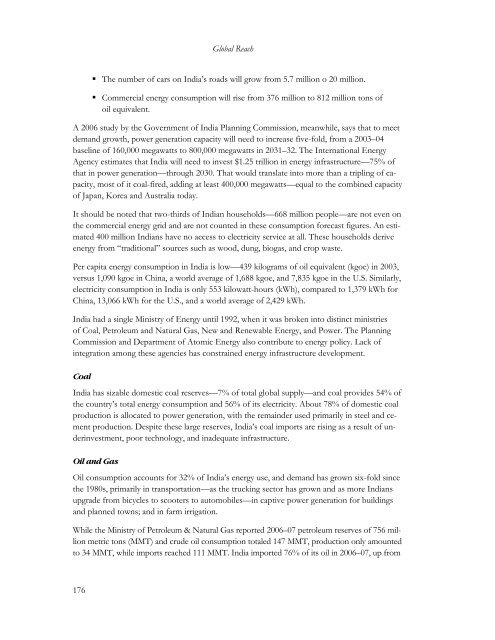PDF: 2962 pages, 5.2 MB - Bay Area Council Economic Institute
PDF: 2962 pages, 5.2 MB - Bay Area Council Economic Institute
PDF: 2962 pages, 5.2 MB - Bay Area Council Economic Institute
Create successful ePaper yourself
Turn your PDF publications into a flip-book with our unique Google optimized e-Paper software.
Global Reach<br />
• The number of cars on India’s roads will grow from 5.7 million o 20 million.<br />
• Commercial energy consumption will rise from 376 million to 812 million tons of<br />
oil equivalent.<br />
A 2006 study by the Government of India Planning Commission, meanwhile, says that to meet<br />
demand growth, power generation capacity will need to increase five-fold, from a 2003–04<br />
baseline of 160,000 megawatts to 800,000 megawatts in 2031–32. The International Energy<br />
Agency estimates that India will need to invest $1.25 trillion in energy infrastructure—75% of<br />
that in power generation—through 2030. That would translate into more than a tripling of capacity,<br />
most of it coal-fired, adding at least 400,000 megawatts—equal to the combined capacity<br />
of Japan, Korea and Australia today.<br />
It should be noted that two-thirds of Indian households—668 million people—are not even on<br />
the commercial energy grid and are not counted in these consumption forecast figures. An estimated<br />
400 million Indians have no access to electricity service at all. These households derive<br />
energy from “traditional” sources such as wood, dung, biogas, and crop waste.<br />
Per capita energy consumption in India is low—439 kilograms of oil equivalent (kgoe) in 2003,<br />
versus 1,090 kgoe in China, a world average of 1,688 kgoe, and 7,835 kgoe in the U.S. Similarly,<br />
electricity consumption in India is only 553 kilowatt-hours (kWh), compared to 1,379 kWh for<br />
China, 13,066 kWh for the U.S., and a world average of 2,429 kWh.<br />
India had a single Ministry of Energy until 1992, when it was broken into distinct ministries<br />
of Coal, Petroleum and Natural Gas, New and Renewable Energy, and Power. The Planning<br />
Commission and Department of Atomic Energy also contribute to energy policy. Lack of<br />
integration among these agencies has constrained energy infrastructure development.<br />
Coal<br />
India has sizable domestic coal reserves—7% of total global supply—and coal provides 54% of<br />
the country’s total energy consumption and 56% of its electricity. About 78% of domestic coal<br />
production is allocated to power generation, with the remainder used primarily in steel and cement<br />
production. Despite these large reserves, India’s coal imports are rising as a result of underinvestment,<br />
poor technology, and inadequate infrastructure.<br />
Oil and Gas<br />
Oil consumption accounts for 32% of India’s energy use, and demand has grown six-fold since<br />
the 1980s, primarily in transportation—as the trucking sector has grown and as more Indians<br />
upgrade from bicycles to scooters to automobiles—in captive power generation for buildings<br />
and planned towns; and in farm irrigation.<br />
While the Ministry of Petroleum & Natural Gas reported 2006–07 petroleum reserves of 756 million<br />
metric tons (MMT) and crude oil consumption totaled 147 MMT, production only amounted<br />
to 34 MMT, while imports reached 111 MMT. India imported 76% of its oil in 2006–07, up from<br />
176








